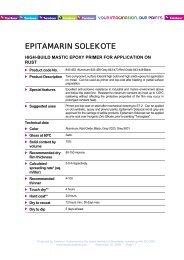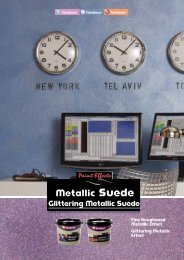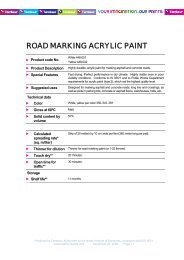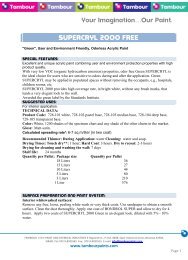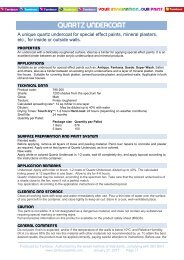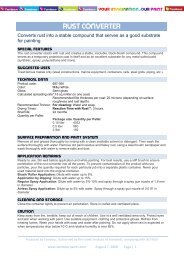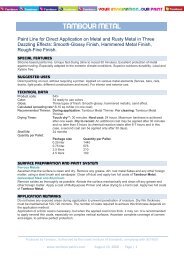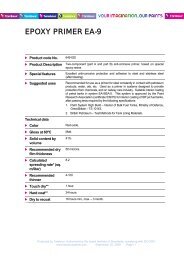You also want an ePaper? Increase the reach of your titles
YUMPU automatically turns print PDFs into web optimized ePapers that Google loves.
Apply a generous quantity of paint to the wall, using diagonal (X – crosswise) strokes. After covering a given<br />
area, go over it with a soft, pliable plastic trowel, with rounded ends, using long left-to-right strokes, to<br />
achieve smooth areas with different degrees of refraction from right and left. The play of colors gives the<br />
sheen and appearance of cashmere fabric.<br />
For a rich look, use the trowel very lightly, without applying undue pressure.<br />
It is recommended to work each time on a sector 0.5 to 1 m diagonally across, and to ensure complete<br />
coverage. Keep away from the wall!<br />
Every so often, step back and look at the effect of the whole picture.<br />
If you choose a light shade, it is advisable to apply an additional coat after drying. Take a close look at areas<br />
where you have applied a thick layer of paint. If there is any tendency to run, smooth the paint over again.<br />
For a “brushed” look:<br />
Stir the paint well before use, and from time to time during painting.<br />
Dip a brush (3” to 4” width) into the container of paint.<br />
Apply a generous quantity of paint to the wall, using diagonal (X – crosswise) strokes.<br />
It is recommended to work each time on a sector 0.5 to 1 m diagonally across, and to ensure complete<br />
coverage. Every so often, step away from the wall and take a look at the effect of the whole picture.<br />
If you have chosen a light shade, apply an additional coat after drying. Take a close look at areas where you<br />
have applied a thick layer of paint. If there is any tendency to run, smooth the paint over again.<br />
For a smooth, uniform look:<br />
Stir the paint well before use, and from time to time during painting.<br />
Dilute with 5-15% water, for easy work with the roller.<br />
Roll on two or three coats with a short-haired roller, with uniform movements and a light finishing touch, to be<br />
sure that no marks remain.<br />
Take a close look at areas where you have applied a thick layer of paint. If there is a tendency to run,<br />
smooth the paint over again.<br />
For a wild, silky look:<br />
Use seaweed mesh or an imitation chamois cloth. Dip into a little Cashmere paint and dab on the wall at<br />
intervals, so that the underlying Supercryl is partially exposed, giving play of shades and of gloss.<br />
A little practice on a piece of cardboard is advisable.<br />
To obtain a tapestry-like effect:<br />
Stir the Cashmere paint well before use, and from time to time during painting.<br />
Dilute with 5-15% water, for easy work with the roller.<br />
Roll on two coats with a short-haired roller.<br />
After drying, apply Supercryl in a similar shade, using a patterned roller with the desired pattern.<br />
Note:<br />
Produced by <strong>Tambour</strong>, Authorized by the Israeli Institute of Standards, complying with ISO 9001<br />
www.tambourpaints.com January 27, 2011 Page | 2



